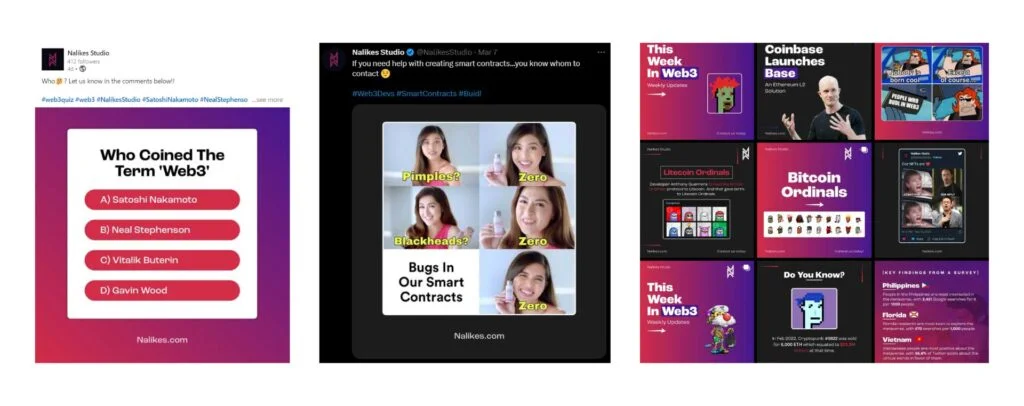If you are already working in web3, congrats on helping build the next stage of the internet.
But the hardest part is letting people know what you are building and making them care about it.
There are tons of crypto, and NFT scams out there. Many still believe that Bitcoin is a scam.
A lot of Defi protocols saw millions of dollars worth of hacks.
And in all this chaos, how do you make sure you cut through the clutter and explain that your web3 product is something they should care about?
Well, I’d say that we start with web2 social media platforms. But before that, we need to find whom we are targeting.
First of all, whether it’s an NFT project or a DeFi protocol, or a 3d virtual world you are building, the first type of audience you’ll attract is the crypto people.
The people who already have a Metamask wallet, who know how to swap ETH to USDC, and also who send me 1BTC every now and then (jk!).
These are the people who want to learn about your product or a web3 service and want to get in when there is a need for them.
But for that, you need to push content through social platforms and let them know the message.
And to do that, we first start with choosing the right marketing channels.
Twitter & Discord are the two platforms where you find a lot of crypto-native people. But your goal shouldn’t be to attract only the crypto people.
If a non-crypto person (one who doesn’t have any knowledge of how crypto works) can benefit from your product, you should market the product to them too (assuming that you have a non-crypto strategy to onboard people like how Reddit onboarded millions with NFTs).
Instagram and TikTok are great for reaching a wider audience. And almost every business should be on Linkedin.
Hence:
This is the case in general. But it ultimately depends on what product or service you are selling and how much resources you have (time, money, employees) to spend on these platforms.
Now that you know where you should be, let’s focus on what you should be posting.
Some of the most common web3 content types are Educational content (how to, why, what is), Memes (web3 and the crypto world runs through memes), and showcasing the work you do (transparency is quite important in the web3 space).
Posting a lot of content, and making sure people see you quite often on social media will create a positive impact on your brand. Also, because the goal is to be active on multiple social media platforms, creating content for one platform and then repurposing that for multiple social platforms is always a good (probably the best) thing to do!
Now, to support the concept of content types + repurposing, here are some ideas (random) to get your creative juices flowing:
Here are some content pieces I’ve created for Nalikes Studio (it’s a web3 development studio):

I also wrote an article on 20 powerful content ideas that any business can try for social media strategy. I recommend reading that, which help you find more ideas.
Sit down and create content ideas in bulk. Make a simple content calendar. It’s because you should be knowing what content goes out on which day of the week. Once that is done, use a tool like Buffer or Hootsuite to automate posting. BTW I don’t believe in optimal posting times. Find a time that feels rational.
We didn’t talk about the visual part of social media, right?
Visuals play a tremendous role in spreading the message. In a crowded social media landscape, where people are bombarded with an overwhelming amount of content every day, a visually appealing post can stand out and capture their attention.
Design should be used to help communicate your message more effectively. With tools like Canva (although I personally prefer Adobe tools), it’s not that hard to create a design. Here are some design tips to follow:
If you want to deep dive into this area, I’d recommend reading this article where I gave 15 tips to improve your social media designs.
If you already have a good audience on your discord group, there are some things that you should keep in mind:
Once you have tried the organic efforts from your side, you can start putting money into the platforms (if you have a budget) to get results.
Once you know whom to target, it’s important to have clear goals for your paid advertising campaigns, whether that’s increasing website traffic, generating leads, or driving product sales. This will help you measure the effectiveness of your ads and optimize your strategy over time.
Money doesn’t help without amazing content and appealing visuals. Your ad content should be eye-catching and engaging, with a clear call to action that encourages users to take action. Find ways to tell a compelling story about your product or service.
Finally, because paid advertising is an iterative process, it’s important to test different ad formats, targeting options, and messaging to find what works best for your audience.
Here are some tips for effectively measuring and analyzing your social media performance:
it is important to approach social media marketing for Web3 products and companies with a strategic mindset, focusing on building a community, providing value, and fostering trust.
By doing so, companies can establish themselves as thought leaders and trusted brands within the Web3 ecosystem, ultimately driving growth and success.